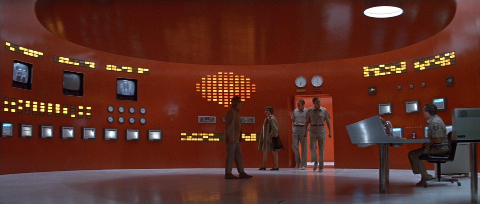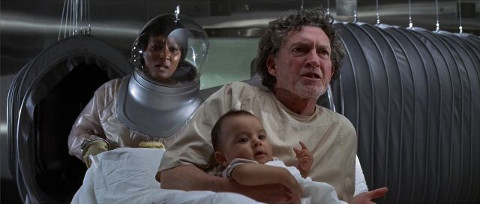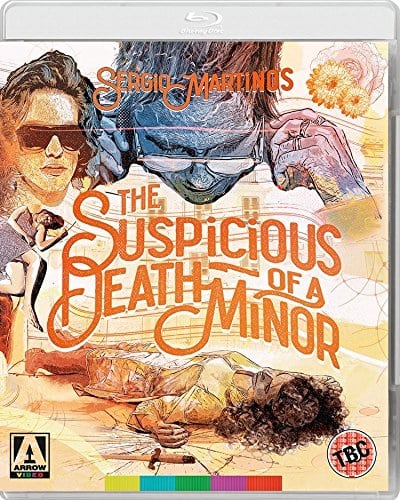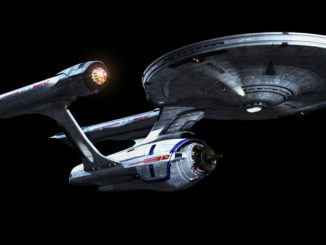The Andromeda Strain (1971)
Directed by: Robert Wise
Written by: Michael Crichton, Nelson Gidding
Starring: Arthur Hill, David Wayne, James Olson, Kate Reid
USA
ON BLU-RAY: 2nd June 2019, from ARROW VIDEO
RUNNING TIME: 131 mins
REVIEWED BY: Dr Lenera, Official HCF Critic
When virtually all of the residents of Piedmont, New Mexico, are found dead after the return to Earth of a space satellite, the head of the US Air Force’s Project Scoop declares an emergency. The military activates an elite scientific four-person team it had previously assembled for this type of emergency. They go to a secret research facility known as Wildfire, and try to first isolate then study the bacteroid life form that was on the satellite, while determining why two people from Piedmont – an old drunk and a six-month-old baby – survived. However, the organism presents a far greater danger in the lab, which is equipped with a nuclear self-destruct device should it manage to escape….
The name of Robert Wise is not usually one that crops up when great directors are mentioned, but the fact remains [well, unless you really do dislike Star Trek: The Motion Picture] that he never seems to have made a really poor film in his entire career. While probably best known for the classic musicals West Side Story and The Sound Of Music, he proved adept at every genre he tackled, though the fact that he did make films of many kinds, and doesn’t have an easily noticeable style [though I’m sure that a study of his work would stuff to pick up on, and I’ve picked up on a couple of things] have probably limited his appeal for cineastes. Perhaps the fact that be began his directorial career chopping down and filming new scenes to The Magnificent Ambersons while Orson Welles’s original cut has been lost forever has forever tarnished his reputation for many, even if he did it at the instructions of the studio. He first displayed an affinity with science fiction in The Day The Earth Stood Still which was one of the first and probably the most restrained and sober of the many alien visitation films that came along in the ‘50s – and those words “restrained” and “sober” can also be applied to The Andromeda Strain, a film which had always passed me by until now. In a way it’s a movie that shouldn’t really work because nearly all of its running time is taken up with exposition, with scientists and doctors talking, running tests, studying readouts on monitors and printouts from teleprinters, and working giant remote arms behind glass panels. And yet, somehow, it really comes off, is totally absorbing and is even pretty frightening, indeed more so than many of the other entries in the ‘contagtion’ or ‘deadly virus’ subgenre. Perhaps it’s because it feels rather authentic, seems almost believable, and is also so different to how it would probably be made today.
Michael Crichton wrote the rough draft for his 1969 novel while he was still a medical student. He was inspired after a conversation with one of his teachers about the concept of crystal-based life-forms. When Universal bought the film rights, screenwriter Nelson Gidding stuck fairly closely to the book, though he change the male Dr. Peter Leavitt into the female Dr. Ruth Leavitt. Wise didn’t like this, picturing Ruth as a largely decorative character reminiscent of Raquel Welch’s in Fantastic Voyage. Wise resolved the question by asking the opinion of some scientists, who were unanimously enthusiastic about the idea. Eventually Wise came to consider Ruth to be the most interesting character in the film. $250,000 of the budget went on the special effects, the movie being the first major one to use advanced computerised [or optical] photographic visual effects after 2001: A Space Odyssey, though much of the lab equipment was real and borrowed. The fictional town of Piedmont was actually Shafter, Texas. At the plane crash site, the actor who was supposed to call out, “Major Mancheck,” fell out of his trailer and broke his leg. He was replaced on the spot with Robert ‘Bob’ Olen, who did the lines but was never credited for it. A scene involving the team submerging totally in an antibiotic solution was cut but a line referring to the act remained. The film was a reasonable hit, and both effects footage and props were reused in TV’s The Six Million Dollar Man, The Bionic Woman, Knight Rider and Airwolf for more than a decade after. Some video versions cut most of the ‘searching the town’ scene, from some reason. There was a 2008 TV mini-series.
After some opening text claiming that what you see really happened, the opening titles are genuinely chilling, Gil Melle’s nerve jangling electronic music playing over shots of files, maps, scientific data on screens, and a virus. Some military personnel are in Piedmont, investigating a crashing satellite, but we’re then back in headquarters so we only hear over the radio when they see lots of dead bodies and are killed by something [a bit which couldn’t help but remind me of the funny ending of Zombie Flesh Eaters]. And then the film does something that in lesser hands could very well have been an act of self-sabotage. It flashes forward [and does so again a few times later] to after the main events of the film, with Dr. Jeremy Stone testifying to a committee, therefore telling us that Stone survived, and that things never turned out that bad, though of course we don’t know the exact details. I still can’t understand why Gidding decided to do this, as it’s not in the novel unless the detailed synopsis that I read of it was inaccurate. But it only succeeds in slightly hampering things and after a while it ceased to bother me, while you do get some flashbacks to further back too. Stone and Dr. Mark Hall explore the town in a really creepy sequence, the dead bodies in strange and unsettling poses [odd how a film with things like lots of corpses including a topless female, a slit wrist, a reference to marijuana and the bottom of a man’s face dissolving got a ‘G’ rating – equivalent to ‘U’ in the UK – certificate in American cinemas]. The other two scientists in this emergency team, Dr. Charles Dutton and Dr. Ruth Leavitt, are summoned from their academic and research appointments to the top-secret lab Wildfire, a massive, high-tech underground facility in Nevada where the interior design seems like a continuation of the spaceship insides in 2001. Immediately the scientists, played very well by Arthur Hill, David Wayne, Kate Reid and James Olson, convince: they’re fallible and have real emotions, yet are all there to do a job and are thrilled by discovering, researching, learning – qualities that this film celebrates in addition to teamwork.
Even I admit that perhaps too much time is spent on the elaborate decontamination process that they undergo, but I was fascinated by so many of the details, like the way each of the five levels are a different colour for psychological reasons, and each one being cleaner than the one above it – and just wait till you see those incredible suits with endless backs. Instead of the one computer voice in the Stanley Kubrick film, there are voices everywhere instructing and advising, leading to an amusing bit where Hall seems to rather like the female voice speaking to him and is told by a male voice that it’s from a 63 year old and to, “adopt a more serious attitude”. Leavitt’s cranky responses also lighten up a film that does threaten to become too dry, but perhaps its biggest success is that, while it relies so much on scientific discussion, it’s always reasonably easy to understand, and this is coming from someone who hates it when movies lapse into a load of technical gooblygook. And I would imagine that Crichton, as usual, did some research to ensure many details were as correct as they could be. Despite all this, suspense does quietly build as we learn that this facility includes an automatic nuclear self-destruct mechanism to incinerate all infectious agents if need be, with Hall being entrusted with the only key that can deactivate the device. Of course the military want to destroy Piedmont, but research on the green, throbbing alien organism reveals that’s actually the very last thing that they should do. We get a twist that today probably seems most logical, plus some climactic heroics, but no really over-the-top behaviour in a film which suggests that using the intellect to tackle a problem can be as thrilling as employing the fist or the gun.
The interiors don’t have much variety but they probably wouldn’t if this place was real anyway, and we do sometime go outside, like witnessing the fate of a poor pilot who happened to fly over Piedmont at precisely the wrong time – though the actual crash occurs off screen in an odd touch considering they could easily have shown it. Perhaps the strongest emotional engagement comes from the old man [possibly inspired by a similar character from Them!] and especially the baby from Piedmont who we pray will survive. Some may find uncomfortable scenes where a rat and a monkey [who really looks like it was in pain for a few seconds despite what the Blu-ray special features tell us] are used for experimentation. But that’s how things are, and the film neither supports nor denounces this. The technology is of course extremely out of date, but that can’t be helped, and actually much of the film somehow has a rather modern feel. Of course it’s full of the essential Crichton inconsistency – he loves technology, often at the expense of his human characters [readers of Jurassic Park, his only book that I’ve read, will remember all those graphs and diagrams], yet is also frightened of where it’s going. And the plot device of a paper wedge putting the whole lab out of contact with Washington may strike some as being silly – though knowing well how the simplest of things can ruin stuff, I was fine with this. And Wise’s direction is probably more stylish than in any other of his films. Aside from the frequent employment of his favoured spit diopter shots [where one side of the screen focuses on a distant object while the other focuses on something nearby, only that in this film Wise splits the screen into three parts at one point], there’s some great use of split screen, such as Stone and Hall looking into windows next to stills of what they see, and multiple images.
Melle’s score is highly unsettling and I only wish it had been utilised more, though the film would have then lacked much of its realistic, almost documentary feel. It’s certainly different from the other Crichton-based films, especially the ones he directed himself. They’re usually full of ideas, but remain essentially pulp thrillers, if tending to be very entertaining and never drastically dumbed down. The Andromeda Strain requires some work and patience from the viewer, but if you’re game then I think you’ll be greatly rewarded, and the film will subsequently stick in the mind. But then the late ‘60s/first two thirds of the ‘70s really was the era of intelligent, thought provoking screen science fiction. Like so many others, I love Star Wars [well, the original trilogy], but if you think about, it did all but put at end to what really was a golden age of the genre, when films like The Andromeda Strain were most definitely not the exception. And I really think that Wise deserves some serious appraisal. Maybe I’ll try and do it myself one day.
Rating: 









The Andromeda Strain previously came out on Blu-ray from Universal, but I’m sure that Arrow’s version blows it out of the water. The picture is often pretty grainy, but the grain looks natural and authentic. Flesh tones, something that for some reason don’t always looks great on Blu-ray, seem perfect here. The many split diopter shots only suffer from the tiniest amount of resolution loss, and this probably wouldn’t even be noticeable if you weren’t watching the film with an eye to picking up on as much as possible like I was. Sharpness and density are highly impressive. A very good restoration.
The previous release included a ‘making of’ and a piece on Crichton. This Blu-ray includes both of those and adds some new features. The audio commentary is non-stop with Bryan Reesman jamming in as much stuff about the film as he can – and he even finishes the track by saying that he could have gone more into the science. Maybe he should write a book about it. Cast and crew biographies [one of my commentary bugbears] are concise and to the point, and discussion is well balanced between the film making aspects and the story ones. Crichton’s sole screen cameo is pointed out. Perhaps there’s slightly less production info than I expected, but on the other hand there’s even the odd personal element. A strong track, and one which may leave you appreciating the film more if you didn’t initially very much.
Kim Newman’s typically enjoyable piece examines this subgenre and The Andromeda Strain‘s place in it. As usual, he names several films that you’ll then want to see. He finishes by mocking the “not science fiction but science fact” claim that many filmmakers and writers use to elevate the pedigree of their product. Rather amusingly, the first thing you see and hear on the next special feature is Crichton in 1971 saying that his story is – yes – “not science fiction but science fact”. Most of this 2001 promotional featurette is shown in small clips throughout this typically well put together Laurent Bouzereau documentary, set to the score from the 1982 version of The Thing for some reason. Wise, an older Crichton and special effects man Douglas Trumball relate the story of the conception and production of the film. Some nice facts are learnt such as the references to sources in the book being all made up, and a matte painting which was so good I didn’t even notice it is pointed out. The Crichton featurette has the author/writer/director detail his early career [he published his first books under different names so his medical school professors didn’t find out] and what led to The Andromeda Strain novel. It’s a lot more interesting then it may sound. There’s a bit of repetition in these two older featurettes from the commentary, but not much. Then we have some portions of the screenplay which is illustrated with diagrams, pictures and the like, the full version of which can be accessed on a BD-ROM PDF.
An intelligent, undeniably talky, yet in its own odd way quite exciting sci-fi minor classic in the usual great Arrow restoration and with the usual complimentary and enlightening special features: Highly Recommended.
SPECIAL EDITION CONTENTS
*New restoration by Arrow Films from a 4K scan of the original camera negative
*High Definition (1080p) Blu-Ray presentation
*Original uncompressed mono audio, newly remastered for this release
*Optional English subtitles for the deaf and hard of hearing
*Audio commentary by critic Bryan Reesman
*A New Strain of Science Fiction, a newly-filmed appreciation by critic Kim Newman
The Andromeda Strain: Making The Film, an archive featurette from 2001 directed by Laurent Bouzereau and featuring interviews with director Robert Wise and screenwriter Nelson Gidding
*A Portrait of Michael Crichton, an archive featurette from 2001 directed by Laurent Bouzereau and featuring an interview with author Michael Crichton
*Cinescript Gallery, highlights from the annotated and illustrated shooting script by Nelson Gidding
*Theatrical trailer, TV spots and radio spots
*Image gallery
*BD-ROM: PDF of the 192-page “cinescript” with diagrams and production designs
*Reversible sleeve featuring original and newly commissioned artwork by Corey Brickley
FIRST PRESSING ONLY: Illustrated collector’s booklet featuring new writing on the film by Peter Tonguette and archive publicity materials








Great review
Loved this film many years ago when I saw it.
I think it had an autopsy scene when granules came out of a cut vein. Am I correct in thinking?
Thanks for your kind comment, yes the scene you describe is in it!
So my real ale addled brain is not quite finished. Thanks for reassurance!